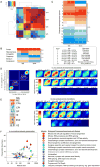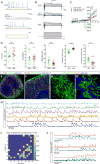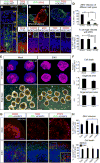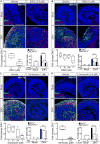Self-Organized Cerebral Organoids with Human-Specific Features Predict Effective Drugs to Combat Zika Virus Infection
- PMID: 29020636
- PMCID: PMC5637483
- DOI: 10.1016/j.celrep.2017.09.047
Self-Organized Cerebral Organoids with Human-Specific Features Predict Effective Drugs to Combat Zika Virus Infection
Abstract
The human cerebral cortex possesses distinct structural and functional features that are not found in the lower species traditionally used to model brain development and disease. Accordingly, considerable attention has been placed on the development of methods to direct pluripotent stem cells to form human brain-like structures termed organoids. However, many organoid differentiation protocols are inefficient and display marked variability in their ability to recapitulate the three-dimensional architecture and course of neurogenesis in the developing human brain. Here, we describe optimized organoid culture methods that efficiently and reliably produce cortical and basal ganglia structures similar to those in the human fetal brain in vivo. Neurons within the organoids are functional and exhibit network-like activities. We further demonstrate the utility of this organoid system for modeling the teratogenic effects of Zika virus on the developing brain and identifying more susceptibility receptors and therapeutic compounds that can mitigate its destructive actions.
Keywords: Zika virus; cerebral cortex; differentiation; embryonic stem cell; human brain; neural development; neural stem cell; neurogenesis; organoid.
Copyright © 2017 The Author(s). Published by Elsevier Inc. All rights reserved.
Figures







References
-
- Eiraku M, Watanabe K, Matsuo-Takasaki M, Kawada M, Yonemura S, Matsumura M, Wataya T, Nishiyama A, Muguruma K, Sasai Y. Self-organized formation of polarized cortical tissues from ESCs and its active manipulation by extrinsic signals. Cell Stem Cell. 2008;3:519–532. - PubMed
-
- Fernandes NC, Nogueira JS, Ressio RA, Cirqueira CS, Kimura LM, Fernandes KR, Cunha MS, Souza RP, Guerra JM. Experimental Zika virus infection induces spinal cord injury and encephalitis in newborn Swiss mice. Exp Toxicol Pathol. 2017;69:63–71. - PubMed
MeSH terms
Substances
Grants and funding
- R01 MH094714/MH/NIMH NIH HHS/United States
- P01 NS083513/NS/NINDS NIH HHS/United States
- U54 HD087101/HD/NICHD NIH HHS/United States
- R01 MH100027/MH/NIMH NIH HHS/United States
- R01 MH110927/MH/NIMH NIH HHS/United States
- R01 AI069120/AI/NIAID NIH HHS/United States
- R00 NS089780/NS/NINDS NIH HHS/United States
- P30 NS062691/NS/NINDS NIH HHS/United States
- R01 MH060233/MH/NIMH NIH HHS/United States
- U01 MH103339/MH/NIMH NIH HHS/United States
- R01 AI056154/AI/NIAID NIH HHS/United States
- R01 NS085227/NS/NINDS NIH HHS/United States
- R01 AI078389/AI/NIAID NIH HHS/United States
- R01 NS089817/NS/NINDS NIH HHS/United States
LinkOut - more resources
Full Text Sources
Other Literature Sources
Medical
Molecular Biology Databases
Miscellaneous

